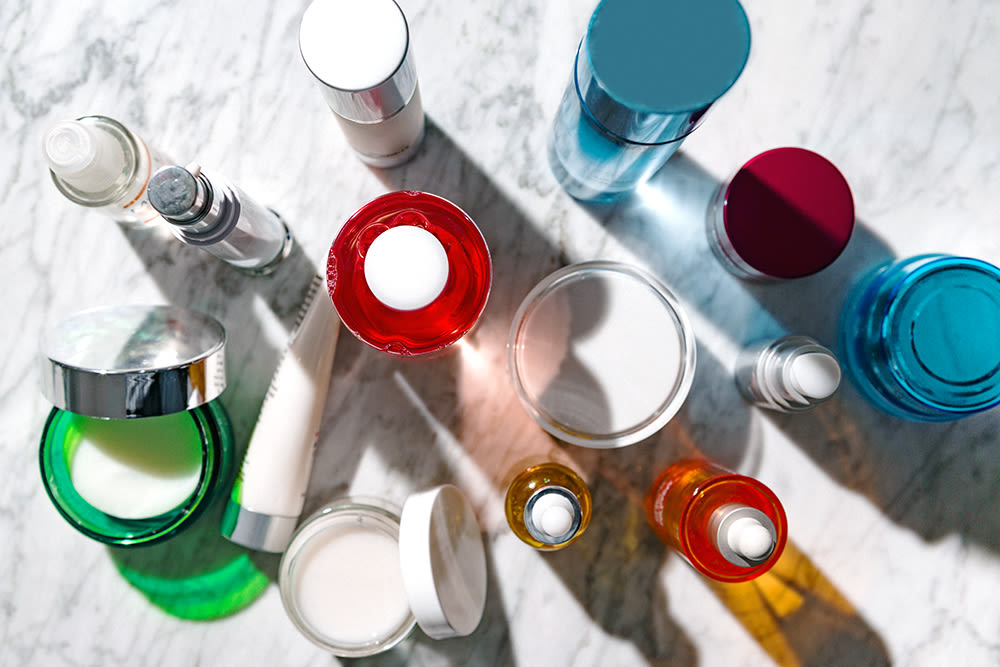Remember in Batman, when the Joker captured our rogue hero, suspended him over a vat of acid in some very belabored but diabolical torture scheme, only to have Batman escape at the last minute using a hidden tool and his general smarts? Neither do we, but it's a formula that sounds right. This is the acid you're introduced to as a child—something dangerous and nefarious, bubbling and green. Don't go anywhere near it unless you're Batman, or Ben Affleck.
Then you're an adult, and before you know it, you're craving acid like an eccentric billionaire on an Ayhuasca retreat. We're referring, of course, to acids for your skin—those delicious skincare ingredients that end in "-ic" and promise smooth, glowing skin, after a brief period of redness. 2017 has seen the boon of chemical exfoliation, and it seems there's a new acid every day, coincidentally offering both better results and gentler application. We'll let you be the judge of that, but first, we'll lay it all out for you. Welcome to the Acid Dictionary. And because dead-skin-eating agents will never not be a little bit frightening, leave any of your outstanding questions in the comments and we'll do our best to answer every single one of them. Let's all come together in the name of everlasting smooth skin.
Acetic Acid
It's vinegar!
It's vinegar. Not recommended alone, but tons of people use Apple Cider Vinegar, which pairs acetic and malic acid, to tone the face, remove scalp build-up, etc. Use with caution.
Azelaic Acid
Antioxidant that occurs naturally in skin. It's derived from yeast, grain, and/or barley. As seen in: The Ordinary's Azelaic 10% Suspension.
Azelaic acid hardly gets any mainstream love, which puts you on the cutting edge for knowing how to pronounce it. (Aza-lay-ic. Good for you!) Traditionally prescribed for rosacea, azelaic fights inflammation, redness, pimples, and swelling. Azelaic acid is classed as a doic (dicarboxylic) acid, a big compound category that is too sciency to get into, but it basically means it's antibacterial and brightening. It's your new best friend and also your soulmate.
Carbolic Acid
Also known as phenol. Infamously found in the OG Biologique Recherche P50.
Whatever you do, don't type "phenol" into EWG's Skin Deep, should you want to preserve your love of Biologique Recherche P50. Carbolic acid is not for the faint of heart—it's a heavy-duty exfoliator that's linked to a handful of hazards, like respiratory toxicity and skin irritation. These kinds of claims typically don't take into account the very small dosage used in cosmetic products, but are helpful to keep in mind. (Especially when the Google autocomplete for carbolic acid is "carbolic acid poisoning.) The many fans of Biologique certainly aren't sweating it.
Citric Acid
Alpha hydroxy acid that you can buy on Amazon.
Citric acid, sold in powder form, is an alpha hydroxy acid that sloughs off dead skin at the surface. But unlike its siblings glycolic and lactic, it's a relatively weak chemical exfoliant—so weak, that it's hardly found in exfoliating products on the market. However, because of its gentle composition, it's a great raw acid to practice mixing your own exfoliant at home if you're into that—at least before graduating to lactic. (We cannot endorse this as a website, but if Amazon.com reviewers are to be believed, it works.) Other than that, there's not much more to say.
Gluconolactone
Enter polyhdroxy acids (PHAs).
PHAs, or polyhydroxy acids, aren't very prevalent in chemical exfoliators—which is why their existance might be news to you. In layman's terms, PHAs are a gentler class of exfoliant than AHAs or BHAs. Products with gluconolactone, one of the most prevalent PHAs (present in P50, as well as Exuviance's anti-aging range), is praised for being effective without the redness, peeling, and sensitivity that comes with heavier-duty acids. But it also doesn't penetrate as deep as they do.
Glycolic Acid
The consummate alpha hydroxy acid. Have you met Ren's Glycolactic Radiance Mask?
Where to begin? Glycolic is everybody's favorite oily skin saver and general clarifying agent—the monarch of all alpha hydroxy acids. Alpha hydroxy acids, this is a good time to note, work on the surface of your skin, while beta hydroxy acids penetrate a little deeper. AHAs are also water-soluble and recommended for dry and normal skin types. Glycolic and lactic are the most popular in this class of acid. Nevermind that glycolic is in almost every chemical exfoliant out there, but there's tons of research backing up its reputation as one of the most effective acids on the market. It gets top marks from Paula's Choice, EWG, and every beauty editor out there.
Lactic Acid
The other favorite alpha hydroxy acid. As seen in: Sunday Riley Good Genes.
Another iconic alpha hydroxy acid, and the lovable sidekick to our favorite glycolic acid. Google it and you're bound to come across buckets of articles discussing lactic acid pertaining to physical exercise—when the body is low on oxygen, carbohydrates break down and create lactic acid (instead of breaking down into H2O and CO2). You do not want a high level of lactic acid in your body, but this has almost nothing to do with the lactic acid that's popularly applied topically as a chemical exfoliant. It's a popular alternative to glycolic because it works in the same way, but it's milder, and works more to moisturize skin while it exfoliates. Does not smell like sour milk, but is sometimes derived from it.
Linoleic Acid
Fatty acid. See also: oleic acid. As seen in: Fresh Seaberry Face Oil.
OK—Linoleic and oleic acids (which usually go hand-in-hand) are not exfoliating acids. BUT! They are sometimes used to treat acne, as many cases of acne have been linked to an imbalance of linoleic and oleic acids in skin. You can read a study about it here. Linoleic and oleic acids are classed as omega-rich "fatty acids", which tons of dermatologists and aestheticians recommend for healthy skin.
Malic Acid
Alpha hydroxy acid derived from apples. As seen in: Juice Beauty's Green Apple range.
An AHA that lacks the exfoliating punch of glycolic and lactic acids, but is more popular than citric acid. Most often it's employed as an exfoliant in concert with other AHAs, as malic acid is also used to adjust the pH of a product towards acidity, but it tends to pop up particularly in brightening exfoliants. (Which means that if skin tone is one of your main concerns, malic might be worth investigating.)
Mandelic Acid
Alpha hydroxy acid. As seen in: Makeup Artist's Choice 25% Mandelic Acid Peel.
Most mandelic peels list the acid in high concentration—like in ITG's favorite MUAC 25% peel—but this is not to scare you off: the acid itself is a gentler AHA than most and a popular acid for sensitive skin and rosacea. It's antibacterial (great for acne!) and exfoliating without brightening like other AHAs, making it a favorite of those of us with deeper skin tones. Also: comes from bitter almonds. The more you know.
Oleic Acid
See also: linoleic acid.
OK—Linoleic and oleic acids (which usually go hand-in-hand) are not exfoliating acids. BUT! They are sometimes used to treat acne, as many cases of acne have been linked to an imbalance of linoleic and oleic acids in skin. You can read a study about it here. Linoleic and oleic acids are classed as omega-rich "fatty acids", which tons of dermatologists and aestheticians recommend for healthy skin.
Retinoic Acid
You know the one.
Vitamin A. Ret-in-ol. Retinoic acid is actually what you're shopping for when looking for a retinoid—when vitamin A and it's deritatives are applied to your skin, it has to be converted to retinoic acid in order to actually work. Anything that bills itself as a retinoid or retinol (including tretinoin) converts to retinoic acid when applied to skin. The stronger the vitamin A, the shorter the conversion time. And as you know, retinol works for everything—acne, fine lines, sun damage, plus the kitchen sink. You can read about that over here.
Salicylic Acid
Beta hydroxy acid. As seen in: the face wash your dermatologist gave you in high school, and also Paula's Choice iconic 2% Perfecting Liquid.
THE Beta Hydroxy Acid. Here's the thing with BHAs—they penetrate deeper than AHAs because they're oil-soluble, journeying to the root of your pores instead of operating at the surface level. This makes them ideal for treating oily and acneic skin, and an extremely effective heavy-duty exfoliant for everyone. Tom loves 'em, and now you do, too.
Tartaric Acid
Alpha hydroxy acid found in wine.
Saving the most obscure for last: tartaric acid. There's not much research available on it, but of every acid on this list, it has the best score on EWG Skin Deep—a difficult source to win over. It is, however, not as stable as its AHA brethren, so it's an unlikely candidate as active exfoliant and is much more popular as a pH balancer. But here's a fun thing: tartaric acid is found in wine and creates things called "wine diamonds", crystals that spontaneously generate at the bottom of the bottle. How fun. We love you, tartaric acid! But we'd rather take glycolic, thank you very much.
Photo via ITG.

